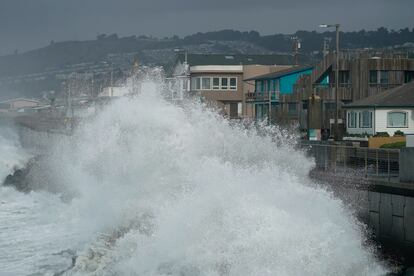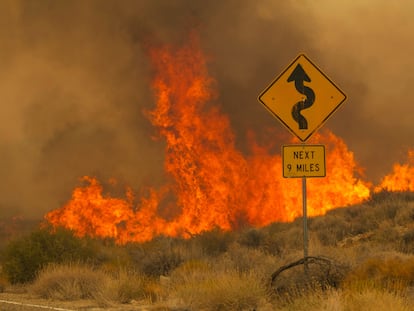Waves grow up to 13 feet tall in California as Earth warms, research finds
Oceanographer Peter Bromirski at Scripps Institution of Oceanography used a unique approach to gather historical data from the past 90 years to track the increasing height of the surf

Waves are getting bigger and surf at least 13 feet (about 4 meters) tall is becoming more common off California’s coast as the planet warms, according to innovative new research that tracked the increasing height from historical data gathered over the past 90 years.
Oceanographer Peter Bromirski at Scripps Institution of Oceanography used the unusual method of analyzing seismic records dating back to 1931 to measure the change in wave height.
When waves ricochet off the shore, they collide with incoming waves and cause a ripple of energy through the seafloor that can be picked up by seismographs designed to detect earthquakes. The greater the impact, the taller the wave is.
Until now, scientists relied on a network of buoys by the National Oceanic and Atmospheric Administration that collect data on wave height along U.S. coasts, but that data along the California coast only went back to 1980.
“Until I stumbled upon this data set, it was almost impossible to make that comparison with any kind of reliability,” Bromirski said.
To go back further, Bromirski gathered a team of undergraduate students to analyze daily seismic readings covering decades of winters. It was a slow, painstaking process that took years and involved digitizing drums of paper records. But he said it was important in learning how things have changed over nearly a century along California’s coast.
They found that average winter wave heights have grown by as much as a foot since 1970, when global warming is believed to have begun accelerating. Swells at least 13 feet tall (about 4 meters) are also happening a lot more often, occurring at least twice as often between 1996 to 2016 than from 1949 to 1969.
Bromirski was also surprised to find extended periods of exceptionally low wave heights prior to about 1970 and none of those periods since.
“Erosion, coastal flooding, damage to coastal infrastructure is, you know, something that we’re seeing more frequently than in the past,” Bromirski said. “And, you know, combined with sea level rise, bigger waves mean that is going to happen more often.”
Changes in waves are showing up in other ways, too.
“There’s about twice as many big wave events since 1970 as there was prior to 1970,” Bromirski said.
The study, published Tuesday in the Journal of Geophysical Research: Oceans, adds to the evidence that climate change is causing massive shifts in the world’s oceans. Other studies have shown waves are not only getting taller but also more powerful.
Damage from intense storms and massive surf is already playing out. This winter, California’s severe storms and giant waves collapsed bluffs, damaged piers and flooded parts of the state’s picturesque Highway 1.
Bromirski said that is a harbinger of the future. Scientists say global warming may even be accelerating, ushering in even bigger waves.
As sea levels rise and storms intensify, bigger waves will cause more flooding in coastal communities, erode away beaches, trigger landslides and destabilize remaining bluffs, he said.
These issues are of particular concern along the California coast, where sea cliffs have already started crumbling and brought down homes in recent years. Because of sea level rise, projections at the end of the 21st century indicate even moderate waves might cause damage comparable to that of extreme weather events, according to the study.
Oceanographer Gary Griggs at the University of California Santa Cruz said while a jump of a foot in wave height over more than 50 years is not huge, the findings are consistent with what scientists know is happening to the world’s oceans as they warm: They are becoming increasingly violent due to more extreme storms and wreaking havoc along coasts.
Griggs, who was not involved in the research, said it adds to growing scientific data showing how fast the world is warming and how quickly seas are rising.
“We know hurricanes are more intense and last longer, and now we’ve got, you know, waves increasing in power. So those are all consistent,” he said. “The challenge ... is sort of how to really respond to that.”
Sign up for our weekly newsletter to get more English-language news coverage from EL PAÍS USA Edition
Tu suscripción se está usando en otro dispositivo
¿Quieres añadir otro usuario a tu suscripción?
Si continúas leyendo en este dispositivo, no se podrá leer en el otro.
FlechaTu suscripción se está usando en otro dispositivo y solo puedes acceder a EL PAÍS desde un dispositivo a la vez.
Si quieres compartir tu cuenta, cambia tu suscripción a la modalidad Premium, así podrás añadir otro usuario. Cada uno accederá con su propia cuenta de email, lo que os permitirá personalizar vuestra experiencia en EL PAÍS.
¿Tienes una suscripción de empresa? Accede aquí para contratar más cuentas.
En el caso de no saber quién está usando tu cuenta, te recomendamos cambiar tu contraseña aquí.
Si decides continuar compartiendo tu cuenta, este mensaje se mostrará en tu dispositivo y en el de la otra persona que está usando tu cuenta de forma indefinida, afectando a tu experiencia de lectura. Puedes consultar aquí los términos y condiciones de la suscripción digital.
More information
Archived In
Últimas noticias
Alain Aspect, Nobel laureate in physics: ‘Einstein was so smart that he would have had to recognize quantum entanglement’
Imelda Castro, the woman who wants to rule the cartel battleground of Sinaloa
The new victims of the Republican war on Obamacare: Millions hit by soaring health insurance premiums
A country divided on migrant rights: Some US states expand protections while others restrict them
Most viewed
- David King, chemist: ‘There are scientists studying how to cool the planet; nobody should stop these experiments from happening’
- Reinhard Genzel, Nobel laureate in physics: ‘One-minute videos will never give you the truth’
- Oona Chaplin: ‘I told James Cameron that I was living in a treehouse and starting a permaculture project with a friend’
- Sinaloa Cartel war is taking its toll on Los Chapitos
- Mexico completes its trade shift with the entry into force of tariffs on China and countries without trade agreements










































